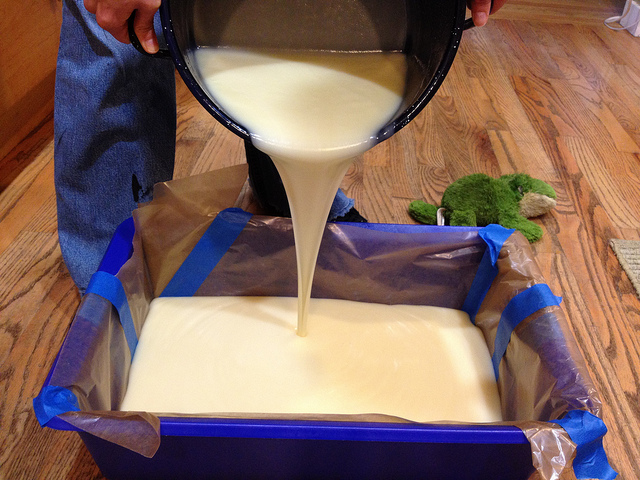It’s important to use the right equipment for homemade soap making – photo courtesy of Flickr user maoquai
Making soap at home can be a fun and rewarding hobby. It’s also essential to have a good soap making guide – it can be dangerous if the soap maker doesn’t research their materials, and take the proper precautions when making homemade soap.
Lye is caustic and corrosive, meaning that it burns like acid when it comes into contact with skin or other surfaces.
Vinegar can help to neutralize lye when it is spilled, and prevent it from damaging surfaces, so it is a good idea to keep some on hand when working with lye.
Also, protect your work area with plastic bags, newspaper, or a vinyl tablecloth; make sure your work space is well-ventilated, because lye tends to evaporate quickly, and releases toxic fumes when it mixes with water.
If at all possible, it’s best to complete the soap making process outside, so that spills and ventilation are non issues.
Keep children and pets away from your work area and materials, and be sure to clean your soap making equipment after each use; store lye properly in a tightly-sealed container, out of the reach of children and pets (Learn more about precautions for working with lye here).
During the soap making process and the clean up, be sure to wear protective equipment, in case you spill the lye on yourself.
A long-sleeve shirt, long pants, socks and shoes are all absolutely necessary.
You’ll also want to don safety goggles, heavy-duty rubber gloves (or latex dishwashing gloves), and a rubber or latex apron; the more protection you have from lye spills or splashes, the better.
Make sure that the rest of the equipment you plan to use – containers, mixers, and more (see below) – is safe for use with lye.
Lye reacts adversely with some materials, such as copper or aluminum, so all containers should be made of glass, stainless steel, enamel, or plastic.
Your equipment list should include, but is not limited to, the following:
- Two sturdy plastic half-gallon pitchers – one for water, one for lye.
- Large heat-resistant container, for mixing the lye and water.
- Large stainless steel mixing bowl – should be large enough to accommodate lye, water and oils, without overflow or splatter.
- Small glass or plastic containers, for holding oils after they are measured and before they are mixed together.
- Two sturdy plastic stirring spoons – one for the lye-water mixture, one for the oils.
- Two glass candy thermometers – one for the lye-water mixture, one for the oils.
- Large (16-qt.) enameled or stainless steel pot, for heating oils.
- Old blanket, for insulating soap molds.
- Kitchen scale or postal scale, accurate to 1 gram or 0.1 ounces.
- Plastic cling wrap or wax paper, for lining soap molds.
- Soap molds – can be anything you like, from elaborate plastic candy molds to wooden boxes to milk cartons or capped PVC pipe sections.
- Stick blender – optional, but will create a much faster trace.
- Pot holders/oven mitts.
- Plastic spatula, to scrape soap batter out of mixing bowl and into molds.
Make sure you have all of your soap making equipment assembled and ready to go before you begin to make your own soap; you can ruin a large batch of batter by stopping to look for something, or running to the store. (Read more about the soap making method here).
An important part of the homemade soap making process is timing, and materials will continue to cool, and saponification will continue to take place, with or without you being there.
Be sure to clean your materials when you are done, use them only for soap making, and keep them all together for the sake of convenience.
Over to you: Do you have any tips on the best equipment to use when you make your own soap? Share in the comments below and let’s all help each other improve our toolikts for our homemade soap.
Take the next step
Download our FREE ebook, ‘How To Make Soap At Home’, by clicking here.
We also have a special offer on our Soap Making Ebooks range, with exclusive web bonuses and a risk free 60 day money back guarantee! Also available on Amazon Kindle, iBooks, Barnes & Noble and Kobo.
